trunk LEXUS RC300 2016 Owner's Guide
[x] Cancel search | Manufacturer: LEXUS, Model Year: 2016, Model line: RC300, Model: LEXUS RC300 2016Pages: 700, PDF Size: 14.12 MB
Page 159 of 700
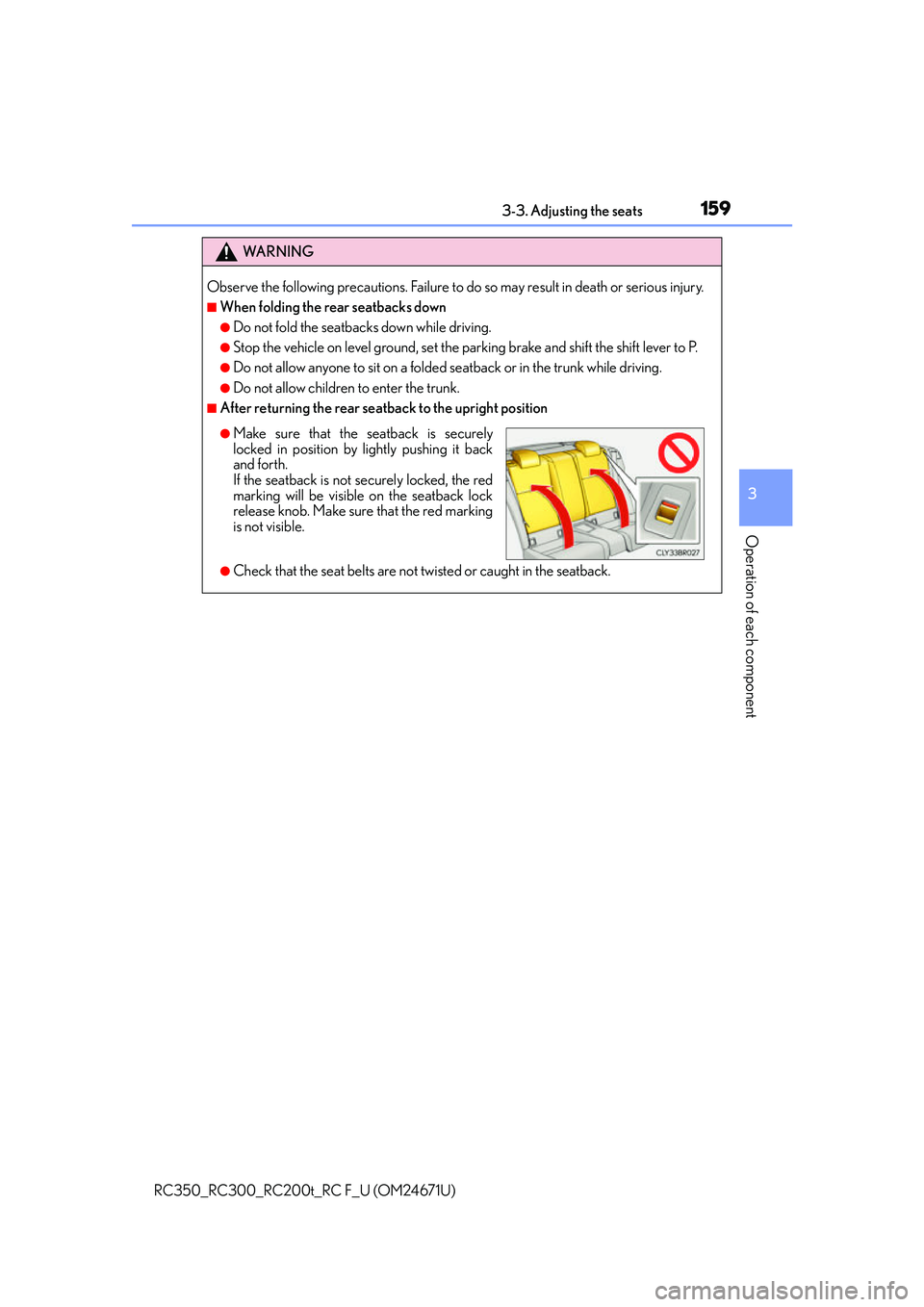
1593-3. Adjusting the seats
3
Operation of each component
RC350_RC300_RC200t_RC F_U (OM24671U)
WA R N I N G
Observe the following precautions. Failure to do so may result in death or serious injury.
‚Ė†When folding the rear seatbacks down
‚óŹDo not fold the seatbacks down while driving.
‚óŹStop the vehicle on level ground, set the parking brake and shift the shift lever to P.
‚óŹDo not allow anyone to sit on a folded seatback or in the trunk while driving.
‚óŹDo not allow children to enter the trunk.
‚Ė†After returning the rear seatback to the upright position
‚óŹCheck that the seat belts are not twisted or caught in the seatback.
‚óŹMake sure that the seatback is securely
locked in position by lightly pushing it back
and forth.
If the seatback is not securely locked, the red
marking will be visible on the seatback lock
release knob. Make sure that the red marking
is not visible.
Page 195 of 700
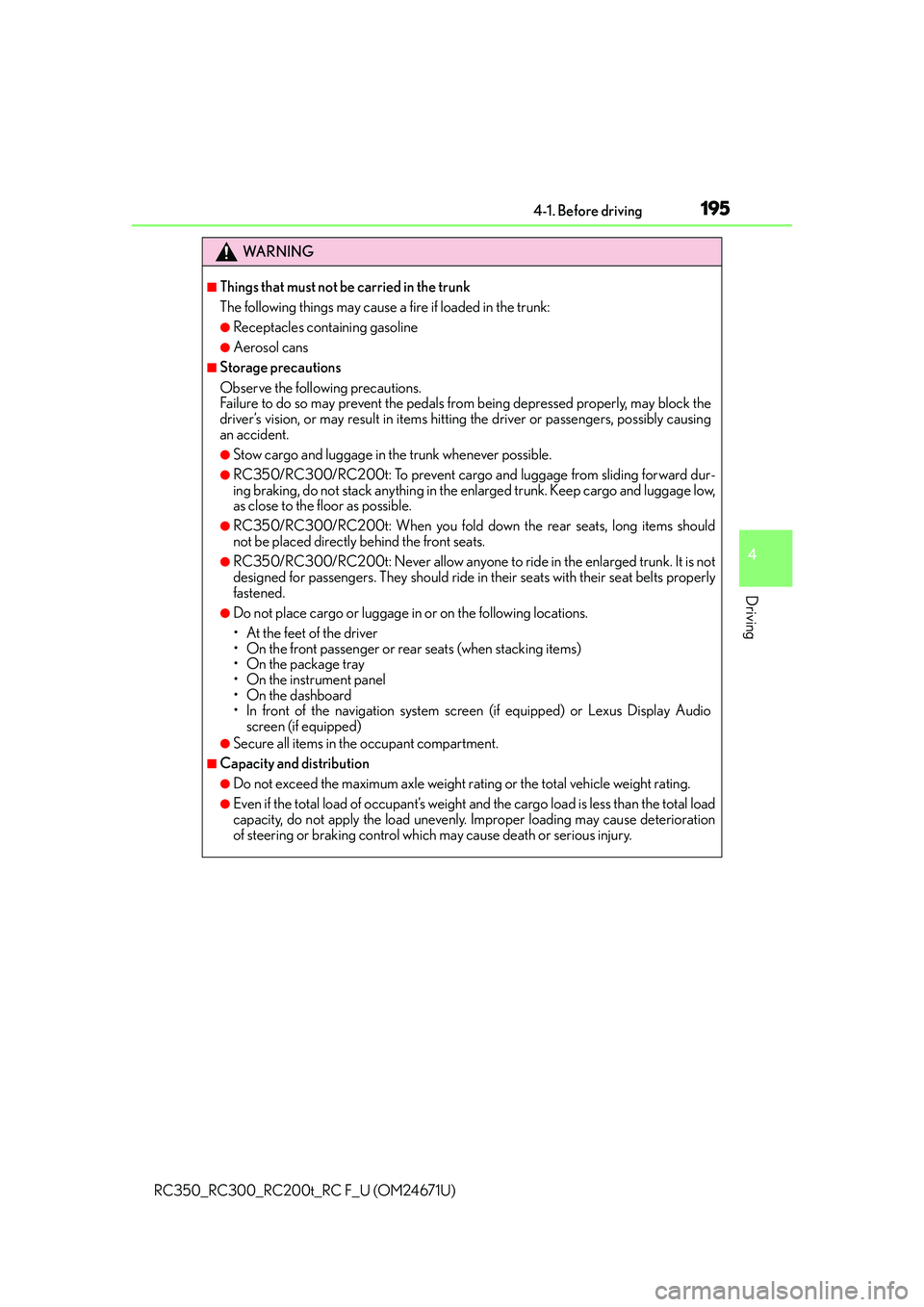
1954-1. Before driving
4
Driving
RC350_RC300_RC200t_RC F_U (OM24671U)
WA R N I N G
‚Ė†Things that must not be carried in the trunk
The following things may cause a fire if loaded in the trunk:
‚óŹReceptacles containing gasoline
‚óŹAerosol cans
‚Ė†Storage precautions
Observe the following precautions.
Failure to do so may prevent the pedals from being depressed properly, may block the
driver’s vision, or may result in items hittin g the driver or passengers, possibly causing
an accident.
‚óŹStow cargo and luggage in the trunk whenever possible.
‚óŹRC350/RC300/RC200t: To prevent cargo and luggage from sliding forward dur-
ing braking, do not stack anything in the enlarged trunk. Keep cargo and luggage low,
as close to the floor as possible.
‚óŹRC350/RC300/RC200t: When you fold down the rear seats, long items should
not be placed directly behind the front seats.
‚óŹRC350/RC300/RC200t: Never allow anyone to ride in the enlarged trunk. It is not
designed for passengers. They should ride in their seats with their seat belts properly
fastened.
‚óŹDo not place cargo or luggage in or on the following locations.
‚ÄĘ At the feet of the driver
‚ÄĘ On the front passenger or re ar seats (when stacking items)
‚ÄĘ On the package tray
‚ÄĘ On the instrument panel
‚ÄĘOn the dashboard
‚ÄĘ In front of the navigation system scre en (if equipped) or Lexus Display Audio
screen (if equipped)
‚óŹSecure all items in th e occupant compartment.
‚Ė†Capacity and distribution
‚óŹDo not exceed the maximum axle weight ra ting or the total vehicle weight rating.
‚óŹEven if the total load of occupant‚Äôs weight and the cargo load is less than the total load
capacity, do not apply the load unevenly. Improper loading may cause deterioration
of steering or braking control which may cause death or serious injury.
Page 215 of 700
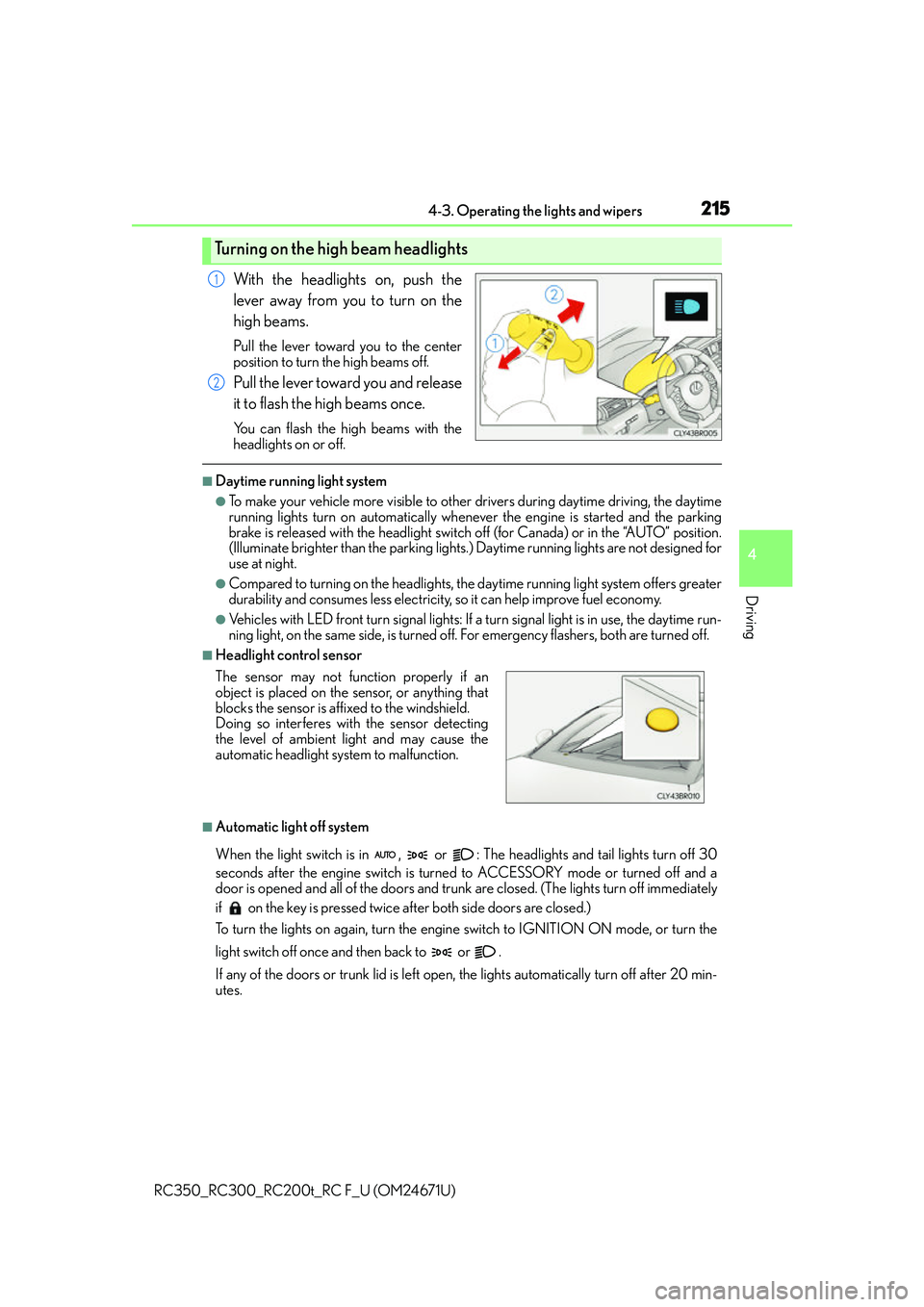
2154-3. Operating the lights and wipers
4
Driving
RC350_RC300_RC200t_RC F_U (OM24671U)
With the headlights on, push the
lever away from you to turn on the
high beams.
Pull the lever toward you to the center
position to turn the high beams off.
Pull the lever toward you and release
it to flash the high beams once.
You can flash the high beams with the
headlights on or off.
‚Ė†Daytime running light system
‚óŹTo make your vehicle more visible to other drivers during daytime driving, the daytime
running lights turn on automatically whenever the engine is started and the parking
brake is released with the headlight switch off (for Canada) or in the ‚ÄúAUTO‚ÄĚ position.
(Illuminate brighter th an the parking lights.) Daytime running lights are not designed for
use at night.
‚óŹCompared to turning on the headlights, the daytime running light system offers greater
durability and consumes less electricity, so it can help improve fuel economy.
‚óŹVehicles with LED front turn signal lights: If a turn signal light is in use, the daytime run-
ning light, on the same side, is turned off. For emergency flashers, both are turned off.
‚Ė†Headlight control sensor
‚Ė†Automatic light off system
When the light switch is in , or : The headlights and tail lights turn off 30
seconds after the engine switch is turned to ACCESSORY mode or turned off and a
door is opened and all of the doors and trunk are closed. (The lights turn off immediately
if on the key is pressed twice after both side doors are closed.)
To turn the lights on again, turn the engine switch to IGNITION ON mode, or turn the
light switch off once and then back to or .
If any of the doors or trunk lid is left open, the lights automatically turn off after 20 min-
utes.
Turning on the high beam headlights
1
2
The sensor may not function properly if an
object is placed on the sensor, or anything that
blocks the sensor is affixed to the windshield.
Doing so interferes with the sensor detecting
the level of ambient light and may cause the
automatic headlight system to malfunction.
Page 233 of 700
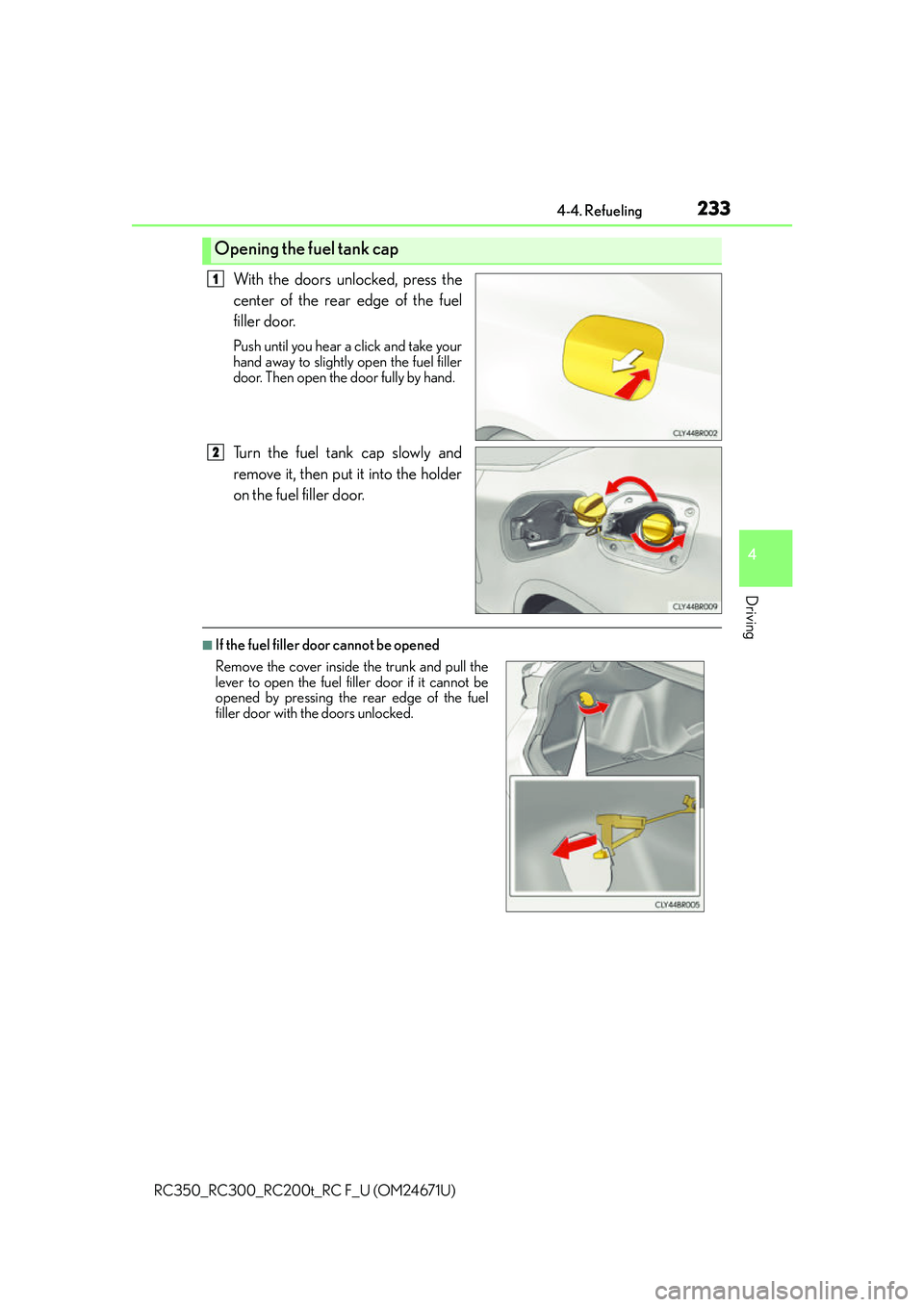
2334-4. Refueling
4
Driving
RC350_RC300_RC200t_RC F_U (OM24671U)
With the doors unlocked, press the
center of the rear edge of the fuel
filler door.
Push until you hear a click and take your
hand away to slightly open the fuel filler
door. Then open the door fully by hand.
Turn the fuel tank cap slowly and
remove it, then put it into the holder
on the fuel filler door.
‚Ė†If the fuel filler door cannot be opened
Opening the fuel tank cap
1
2
Remove the cover inside the trunk and pull the
lever to open the fuel filler door if it cannot be
opened by pressing the rear edge of the fuel
filler door with the doors unlocked.
Page 251 of 700
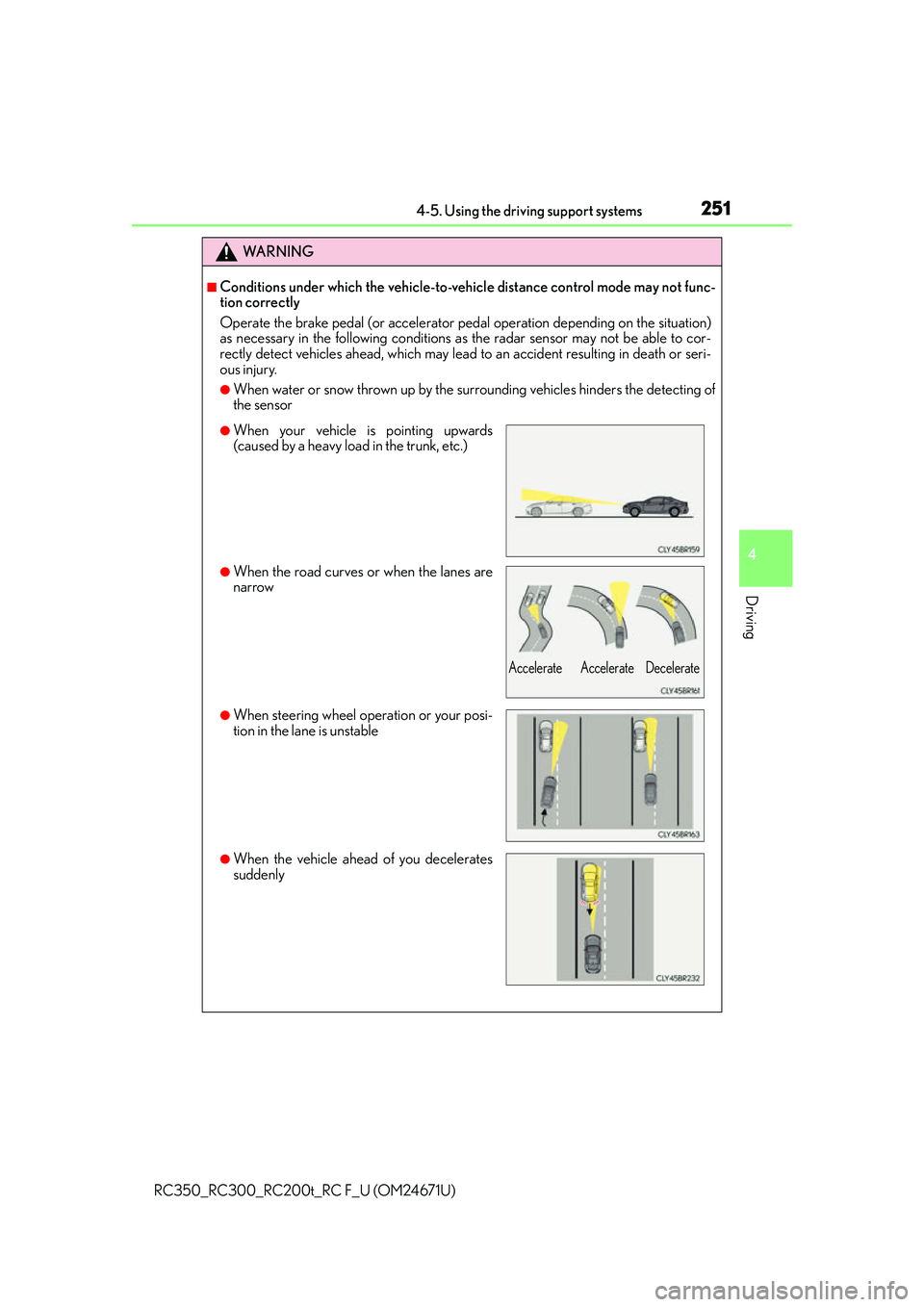
2514-5. Using the driving support systems
4
Driving
RC350_RC300_RC200t_RC F_U (OM24671U)
WA R N I N G
‚Ė†Conditions under which the vehicle-to-vehicle distance control mode may not func-
tion correctly
Operate the brake pedal (or accelerator pe dal operation depending on the situation)
as necessary in the following conditions as the radar sensor may not be able to cor-
rectly detect vehicles ahead, which may lead to an accident resulting in death or seri-
ous injury.
‚óŹWhen water or snow thrown up by the surrounding vehicles hinders the detecting of
the sensor
‚óŹWhen your vehicle is pointing upwards
(caused by a heavy load in the trunk, etc.)
‚óŹWhen the road curves or when the lanes are
narrow
‚óŹWhen steering wheel operation or your posi-
tion in the lane is unstable
‚óŹWhen the vehicle ahead of you decelerates
suddenly
Accelerate Accelerate Decelerate
Page 280 of 700
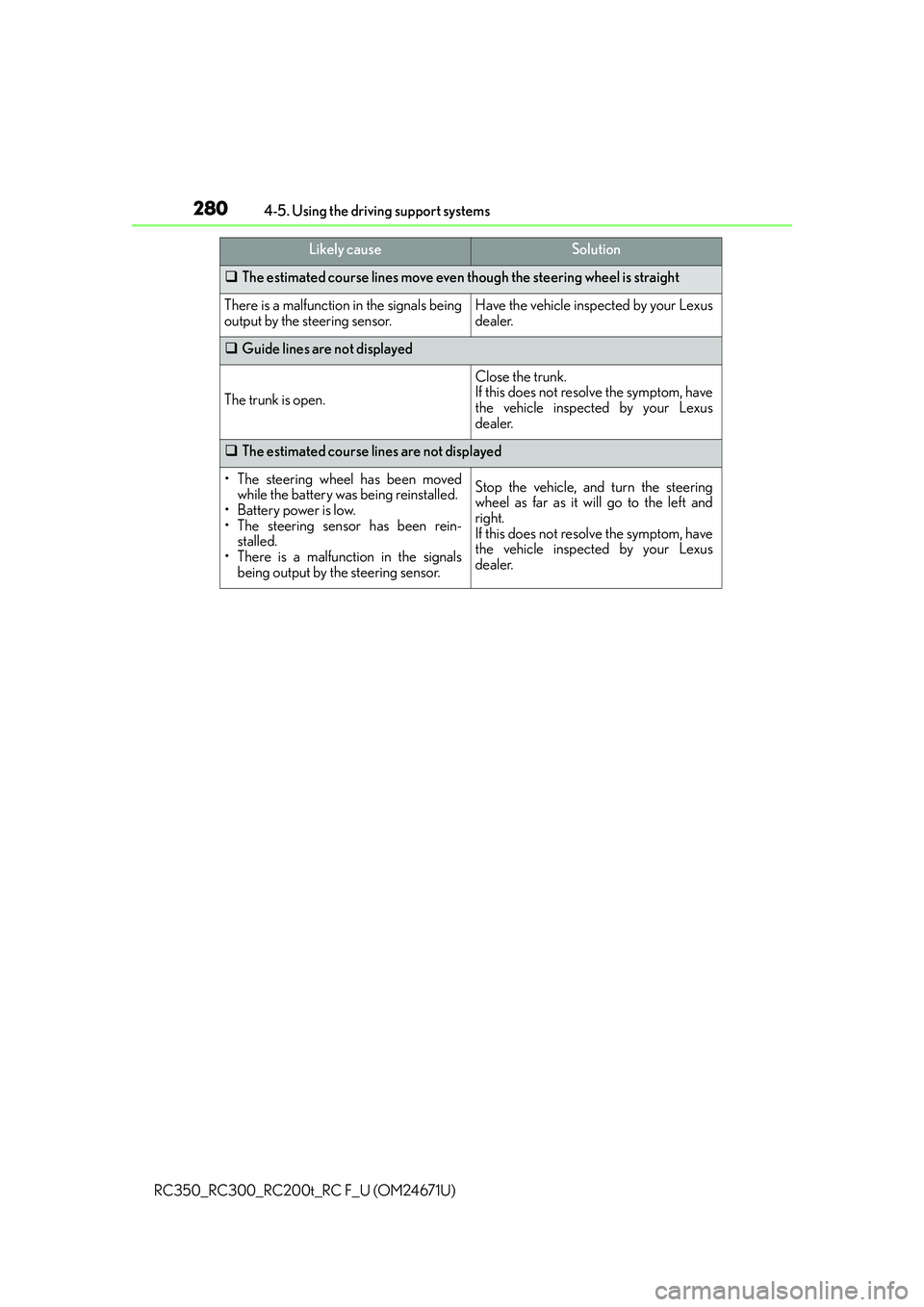
2804-5. Using the driving support systems
RC350_RC300_RC200t_RC F_U (OM24671U)
ÔĀĪ The estimated course lines move even though the steering wheel is straight
There is a malfunction in the signals being
output by the steering sensor.Have the vehicle inspected by your Lexus
dealer.
ÔĀĪ Guide lines are not displayed
The trunk is open.
Close the trunk.
If this does not resolve the symptom, have
the vehicle inspected by your Lexus
dealer.
ÔĀĪThe estimated course lines are not displayed
‚ÄĘ The steering wheel has been moved
while the battery was being reinstalled.
‚ÄĘ Battery power is low.
‚ÄĘ The steering sensor has been rein- stalled.
‚ÄĘ There is a malfunction in the signals being output by the steering sensor.Stop the vehicle, and turn the steering
wheel as far as it will go to the left and
right.
If this does not resolve the symptom, have
the vehicle inspected by your Lexus
dealer.
Likely causeSolution
Page 281 of 700
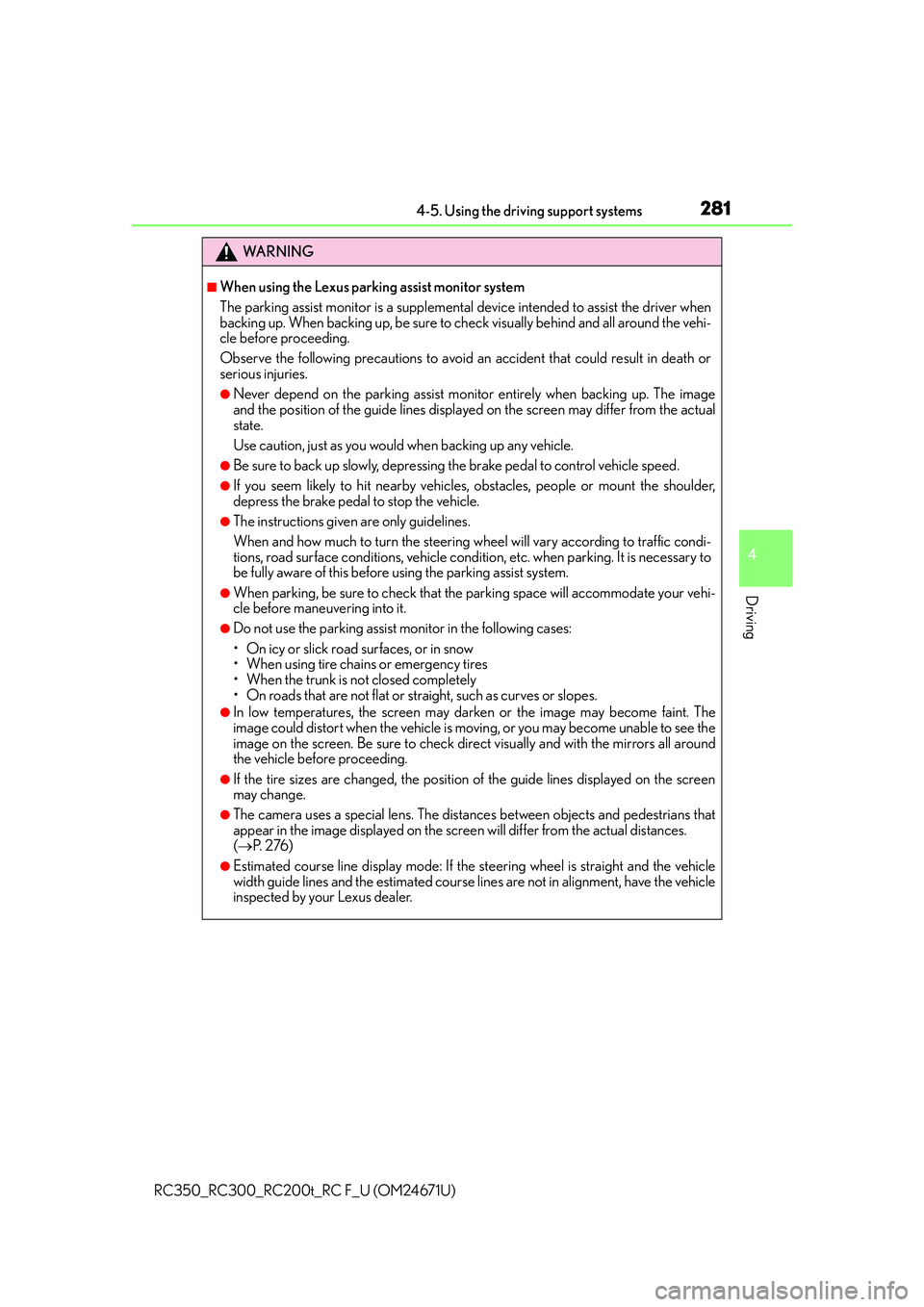
2814-5. Using the driving support systems
4
Driving
RC350_RC300_RC200t_RC F_U (OM24671U)
WA R N I N G
‚Ė†When using the Lexus parking assist monitor system
The parking assist monitor is a supplemental device intended to assist the driver when
backing up. When backing up, be sure to chec k visually behind and all around the vehi-
cle before proceeding.
Observe the following precautions to avoid an accident that could result in death or
serious injuries.
‚óŹNever depend on the parking assist monitor entirely when backing up. The image
and the position of the guide lines displaye d on the screen may differ from the actual
state.
Use caution, just as you would when backing up any vehicle.
‚óŹBe sure to back up slowly, depressing the brake pedal to control vehicle speed.
‚óŹIf you seem likely to hit nearby vehicles, obstacles, people or mount the shoulder,
depress the brake pedal to stop the vehicle.
‚óŹThe instructions given are only guidelines.
When and how much to turn the steering wheel will vary according to traffic condi-
tions, road surface conditions, vehicle condit ion, etc. when parking. It is necessary to
be fully aware of this before using the parking assist system.
‚óŹWhen parking, be sure to check that the par king space will accommodate your vehi-
cle before maneuvering into it.
‚óŹDo not use the parking assist monitor in the following cases:
‚ÄĘ On icy or slick road surfaces, or in snow
‚ÄĘ When using tire chains or emergency tires
‚ÄĘ When the trunk is not closed completely
‚ÄĘ On roads that are not flat or straight, such as curves or slopes.
‚óŹIn low temperatures, the screen may darken or the image may become faint. The
image could distort when the vehicle is moving, or you may become unable to see the
image on the screen. Be sure to check dire ct visually and with the mirrors all around
the vehicle before proceeding.
‚óŹIf the tire sizes are changed, the position of the guide lines displayed on the screen
may change.
‚óŹThe camera uses a special lens. The dist ances between objects and pedestrians that
appear in the image displayed on the screen will differ from the actual distances.
( Ôāģ P. 2 76 )
‚óŹEstimated course line display mode: If the st eering wheel is straight and the vehicle
width guide lines and the estimated course li nes are not in alignment, have the vehicle
inspected by your Lexus dealer.
Page 298 of 700
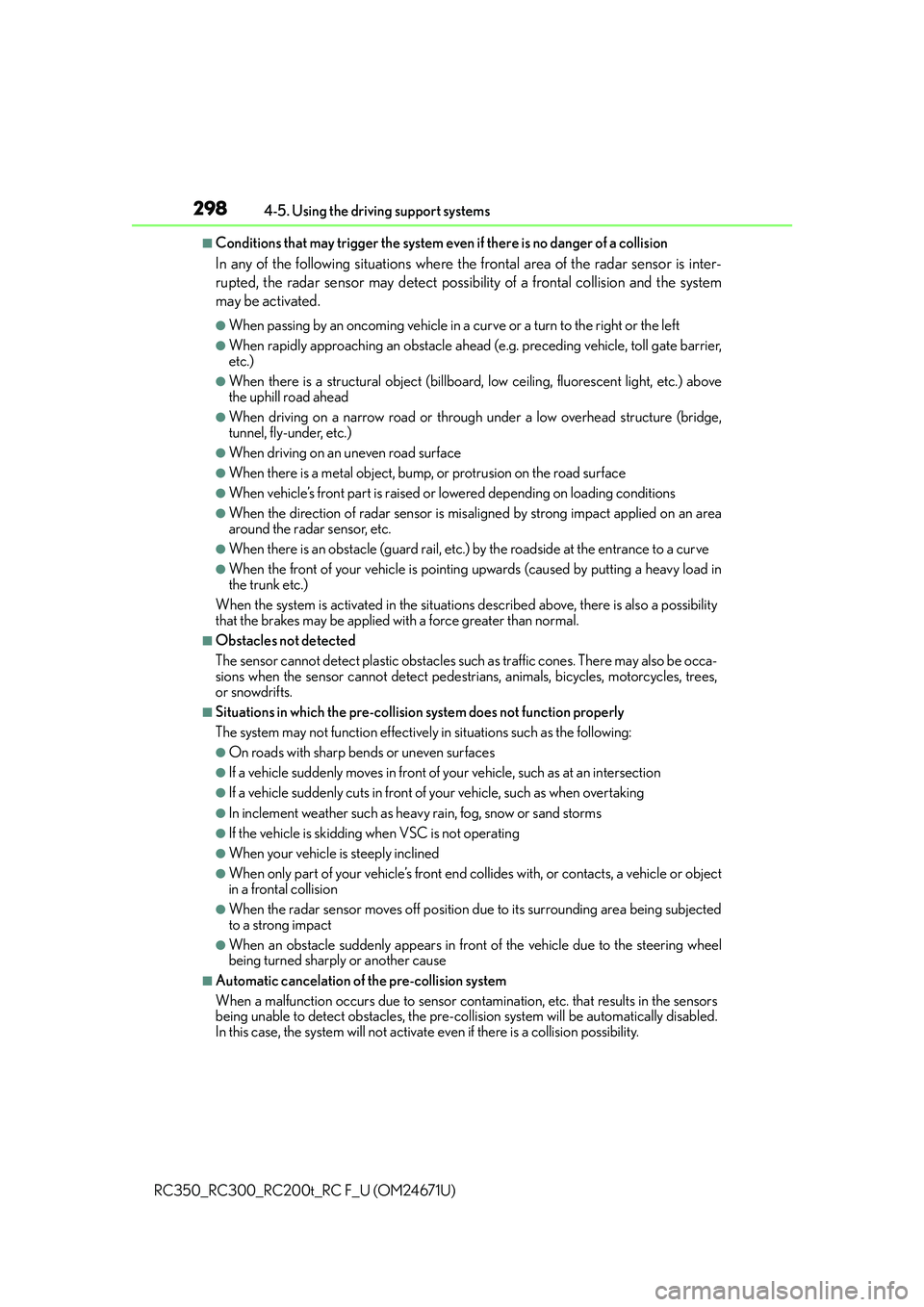
2984-5. Using the driving support systems
RC350_RC300_RC200t_RC F_U (OM24671U)
‚Ė†Conditions that may trigger the system even if there is no danger of a collision
In any of the following situations where the frontal area of the radar sensor is inter-
rupted, the radar sensor may detect possibility of a frontal collision and the system
may be activated.
‚óŹWhen passing by an oncoming vehicle in a curve or a turn to the right or the left
‚óŹWhen rapidly approaching an obstacle ahead (e.g. preceding vehicle, toll gate barrier,
etc.)
‚óŹWhen there is a structural ob ject (billboard, low ceiling, fluorescent light, etc.) above
the uphill road ahead
‚óŹWhen driving on a narrow road or through under a low overhead structure (bridge,
tunnel, fly-under, etc.)
‚óŹWhen driving on an uneven road surface
‚óŹWhen there is a metal object, bump, or protrusion on the road surface
‚óŹWhen vehicle‚Äôs front part is raised or lowered depending on loading conditions
‚óŹWhen the direction of radar sensor is misa ligned by strong impact applied on an area
around the radar sensor, etc.
‚óŹWhen there is an obstacle (guard rail, etc.) by the roadside at the entrance to a curve
‚óŹWhen the front of your vehicle is pointing upwards (caused by putting a heavy load in
the trunk etc.)
When the system is activated in the situations described above, there is also a possibility
that the brakes may be applied with a force greater than normal.
‚Ė†Obstacles not detected
The sensor cannot detect plasti c obstacles such as traffic cones. There may also be occa-
sions when the sensor cannot detect pedestrians, animals, bicycles, motorcycles, trees,
or snowdrifts.
‚Ė†Situations in which the pre-collision system does not function properly
The system may not function effectively in situations such as the following:
‚óŹOn roads with sharp bends or uneven surfaces
‚óŹIf a vehicle suddenly moves in front of your vehicle, such as at an intersection
‚óŹIf a vehicle suddenly cuts in front of your vehicle, such as when overtaking
‚óŹIn inclement weather such as heavy rain, fog, snow or sand storms
‚óŹIf the vehicle is skidding when VSC is not operating
‚óŹWhen your vehicle is steeply inclined
‚óŹWhen only part of your vehicle‚Äôs front end collides with, or contacts, a vehicle or object
in a frontal collision
‚óŹWhen the radar sensor moves off position due to its surrounding area being subjected
to a strong impact
‚óŹWhen an obstacle suddenly appears in front of the vehicle due to the steering wheel
being turned sharply or another cause
‚Ė†Automatic cancelation of the pre-collision system
When a malfunction occurs due to sensor cont amination, etc. that results in the sensors
being unable to detect obstacles, the pre-collision syst em will be automatically disabled.
In this case, the system will not activate even if there is a collision possibility.
Page 316 of 700
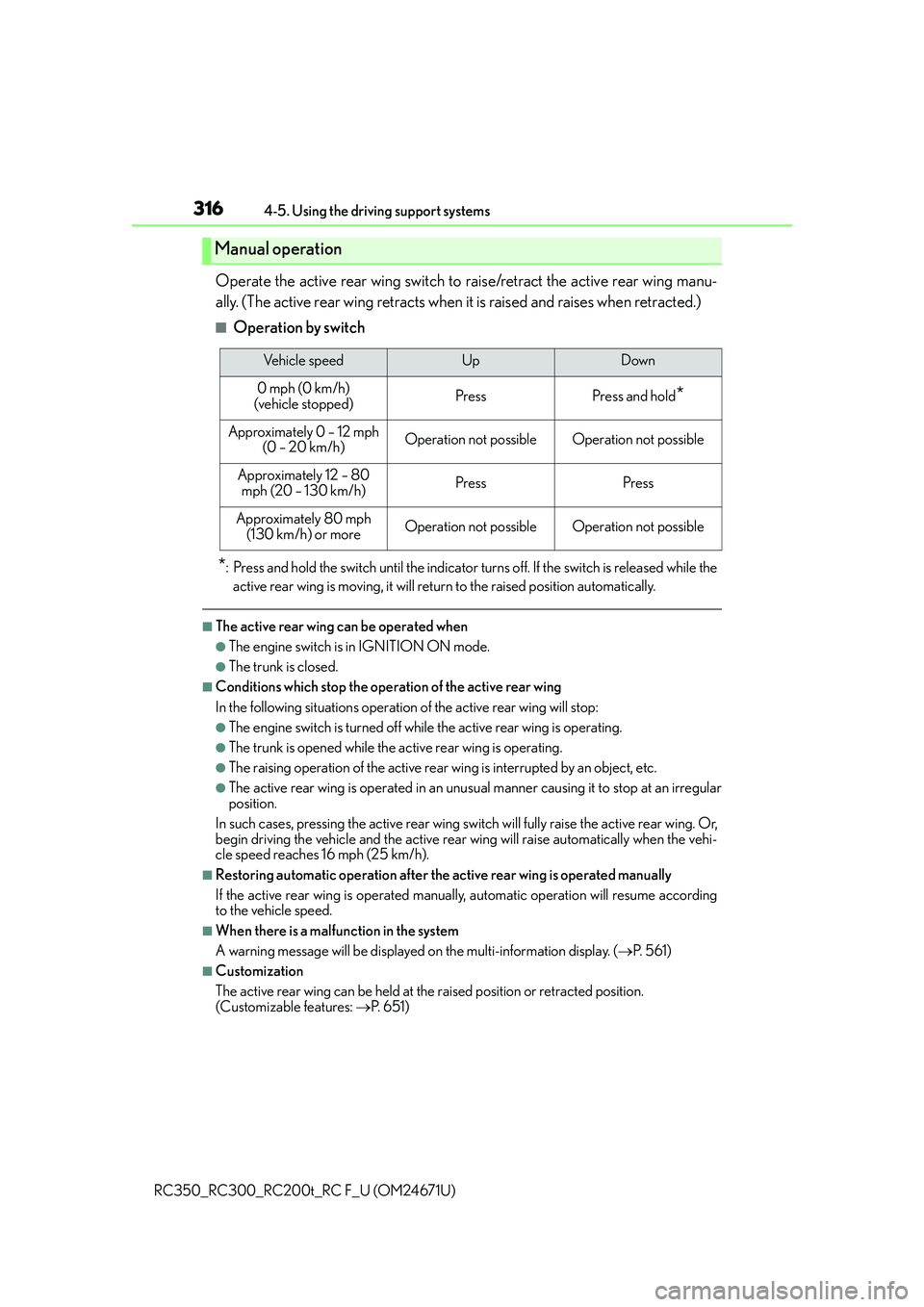
3164-5. Using the driving support systems
RC350_RC300_RC200t_RC F_U (OM24671U)
Operate the active rear wing switch to raise/retract the active rear wing manu-
ally. (The active rear wing retracts when it is raised and raises when retracted.)
‚Ė†Operation by switch
*: Press and hold the switch until the indicator turns off. If the switch is released while the
active rear wing is moving, it will return to the raised position automatically.
‚Ė†The active rear wing can be operated when
‚óŹThe engine switch is in IGNITION ON mode.
‚óŹThe trunk is closed.
‚Ė†Conditions which stop the operation of the active rear wing
In the following situations operatio n of the active rear wing will stop:
‚óŹThe engine switch is turned off while the active rear wing is operating.
‚óŹThe trunk is opened while the active rear wing is operating.
‚óŹThe raising operation of the active rear wing is interrupted by an object, etc.
‚óŹThe active rear wing is operated in an unus ual manner causing it to stop at an irregular
position.
In such cases, pressing the active rear wing switch will fully raise the active rear wing. Or,
begin driving the vehicle and the active rear wing will raise automatically when the vehi-
cle speed reaches 16 mph (25 km/h).
‚Ė†Restoring automatic operation after the active rear wing is operated manually
If the active rear wing is operated manually, automatic operation will resume according
to the vehicle speed.
‚Ė†When there is a malfunction in the system
A warning message will be displayed on the multi-information display. (ÔāģP. 5 6 1 )
‚Ė†Customization
The active rear wing can be held at the raised position or retracted position.
(Customizable features: ÔāģP. 6 5 1 )
Manual operation
Vehicle speedUpDown
0 mph (0 km/h)
(vehicle stopped)PressPress and hold*
Approximately 0 ‚Äď 12 mph (0 ‚Äď 20 km/h)Operation not possibleOperation not possible
Approximately 12 ‚Äď 80 mph (20 ‚Äď 130 km/h)PressPress
Approximately 80 mph
(130 km/h) or moreOperation not possibleOperation not possible
Page 419 of 700
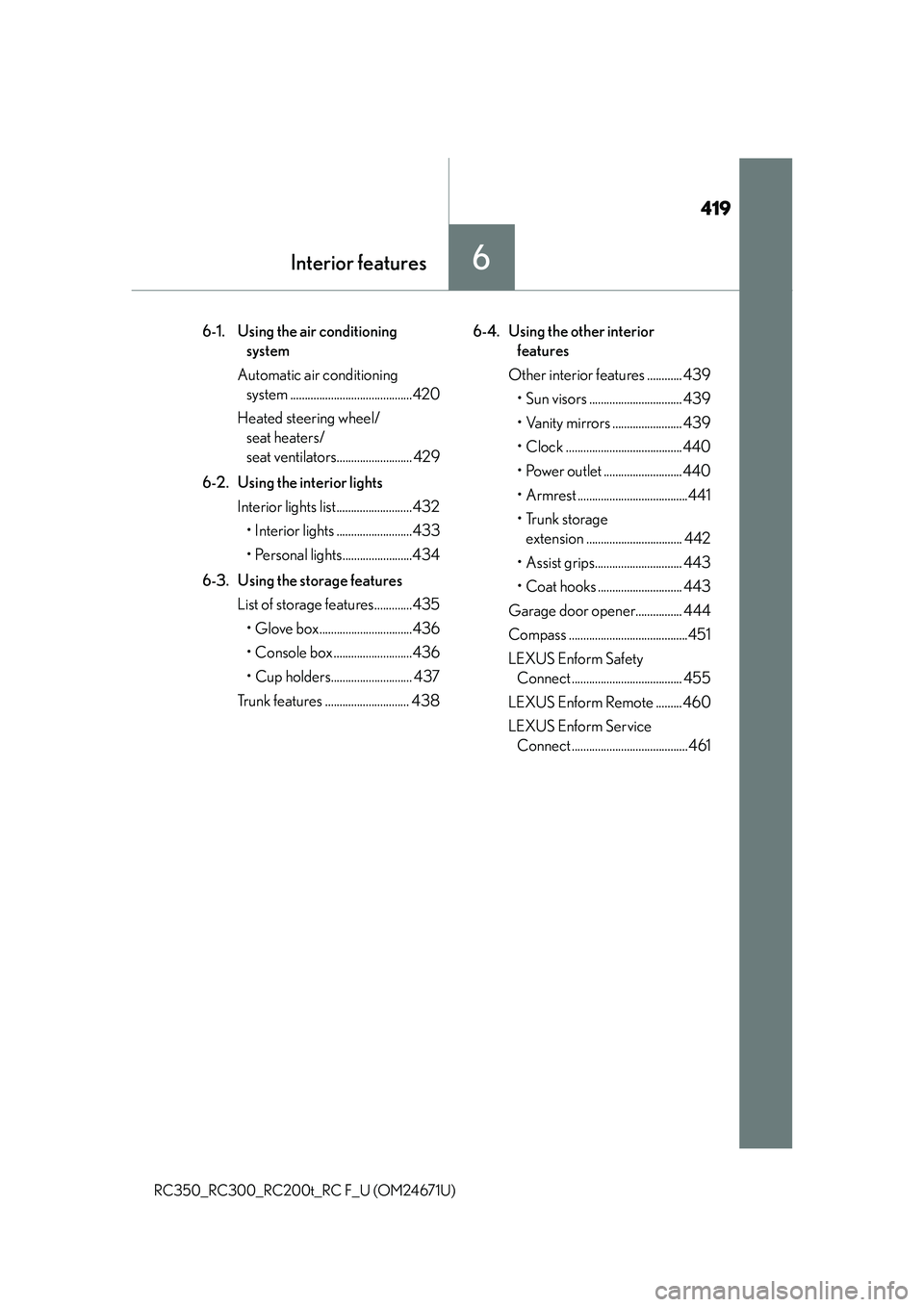
419
Interior features6
RC350_RC300_RC200t_RC F_U (OM24671U)
6-1. Using the air conditioning system
Automatic air conditioning system ..........................................420
Heated steering wheel/ seat heaters/
seat ventilators.......................... 429
6-2. Using the interior lights Interior lights list..........................432‚ÄĘ Interior lights ..........................433
‚ÄĘ Personal lights........................434
6-3. Using the storage features List of storage features.............435‚ÄĘ Glove box................................436
‚ÄĘ Console box ...........................436
‚ÄĘ Cup holders............................ 437
Trunk features ............................. 438 6-4. Using the other interior
features
Other interior features ............ 439 ‚ÄĘ Sun visors ................................ 439
‚ÄĘ Vanity mirrors ........................ 439
‚ÄĘ Clock ........................................440
‚ÄĘ Power outlet ...........................440
‚ÄĘ Armrest ......................................441
‚ÄĘTrunk storage extension ................................. 442
‚ÄĘ Assist grips.............................. 443
‚ÄĘ Coat hooks ............................. 443
Garage door opener................ 444
Compass .........................................451
LEXUS Enform Safety Connect ...................................... 455
LEXUS Enform Remote .........460
LEXUS Enform Service Connect ........................................461